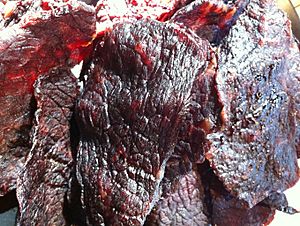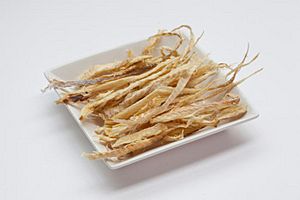Po (food) facts for kids

|
|
| Type | Dried meat or fish |
|---|---|
| Place of origin | Korea |
| Associated national cuisine | Korean cuisine |
| Similar dishes | Jerky |
| Korean name | |
| Hangul |
포
|
|---|---|
| Hanja |
脯
|
| Revised Romanization | po |
| McCune–Reischauer | p'o |
| IPA | [pʰo] |
Po (Korean: 포) is a popular Korean food. It is made from thin strips or sheets of dried meat or fish. You can find Po made from beef, pork, deer, or chicken. It also comes from seafood like whitefish, eel, squid, octopus, shrimp, and crab.
Koreans enjoy Po as a snack. It's also served as banchan (side dishes with rice) or anju (food eaten with drinks). Po is an important part of traditional events. These include pyebaek (wedding greetings) and jesa (family ceremonies for ancestors).
Contents
What's in a Name?
The Korean word po (포) comes from Chinese characters. It can be written with the hanja 脯. In other East Asian cultures, this same character can also mean preserved fruit.
A Look Back: History of Po
The history of Po goes way back to ancient times. People think it started when humans were hunter-gatherers. These early people hunted animals and gathered plants for food. Drying meat and fish helped them store food for a long time.
One old book, Samguk sagi, tells us about Po. In 683, King Sinmun of Silla sent many carts of food, including Po, for a wedding. This shows Po was a valuable food even then.
Later, a Chinese scholar named Wu Ji wrote about Po from Goryeo Korea. He mentioned that Koreans seasoned dried deer meat (called nokpo) with cinnamon.
During the Joseon period in Korea, Po was very important. Special Po called gwanpo was made for government use. Large Po was even made for important ceremonies. At Korean New Year, people often sent Po as gifts to family and officials. Big parties were sometimes called "Po mountains, meat forests" because there was so much food! Beef Po was also used to make a tea snack called upo-dasik.
Po was also prepared for long journeys. A type called Cheolli-po was made from meat marinated in wine, vinegar, and salt. It was meant to last for a "thousand ri" (about 393 kilometers or 244 miles).
Different Kinds of Po
Po comes in many forms, depending on how it's made and what it's made from.
How Po is Prepared
- Geonpo (건포): This is meat or fish that is thinly sliced and then dried.
- Pyeonpo (편포): This type is made from meat that is pounded flat before being dried.
- Poyuk (포육): This is a general term for dried meat.
- Yukpo (육포): This specifically means dried beef slices.
- Eopo (어포): This refers to dried fish.
Some Po is seasoned simply with salt and pepper, called yeompo. Other types are marinated in soy sauce-based seasonings. These include jangpo, pyeonpo, sanpo, or yakpo. The name changes based on how it's seasoned or prepared.
Meat Po
- Nokpo (녹포): Made from venison (deer meat).
- Jeyuk-po (제육포): Pork that is salted, dried, and then dried again after being boiled in diluted wine.
- Yukpo (육포): Dried beef.
- Baepo (배포): Thinly sliced beef or pork, seasoned and dried over a fire.
- Yakpo (약포): Thinly sliced meat seasoned with soy sauce, oil, sugar, and pepper, then dried.
Poultry Po
- Geowi-po (거위포): Made from goose meat.
- Gireogi-po (기러기포): Made from wild goose meat.
- Chiyuk-po (치육포): Made from pheasant meat.
Seafood Po

- Chupo (추포): Dried squid.
- Eopo (어포): Thinly sliced dried fish.
- Saeu-po (새우포): Shrimp that is cut in half, marinated, dried, and grilled.
- Jwipo (쥐포): Dried and pressed thread-sail filefish.
- Muneo-po (문어포): Dried and pressed giant octopus.
- Ojingeo-po (오징어포): Dried and pressed squid.
How Po is Used
Po is a versatile food in Korean cuisine. It's often enjoyed as a quick snack. It can also be a banchan (side dish) served with bap (rice). Or, it can be an anju, which is food eaten with drinks.
Salted and dried meat Po is sometimes eaten as po-jaban, a salty side dish. Crab and other seafood Po can be shredded, seasoned with soy sauce and oil, and eaten as a muchim (a seasoned salad-like dish). Dried fish Po is often grilled after being seasoned with soy sauce or gochujang (Korean chili paste). This grilled dish is called gui.
Po plays a special role in traditional Korean ceremonies. It's one of the foods prepared for pyebaek (a formal greeting after a wedding) and jesa (ancestral rites). For jesa, Po and sikhye (a sweet rice punch) are often placed on the table. This combination is called pohye. There's a saying, jwa-po-u-hye, which means "left Po, right sikhye." This refers to how they are placed on the ancestral rite table. Simple offerings for jesa are sometimes called ju-gwa-po-hye, meaning "wine, fruit, Po, sikhye."

